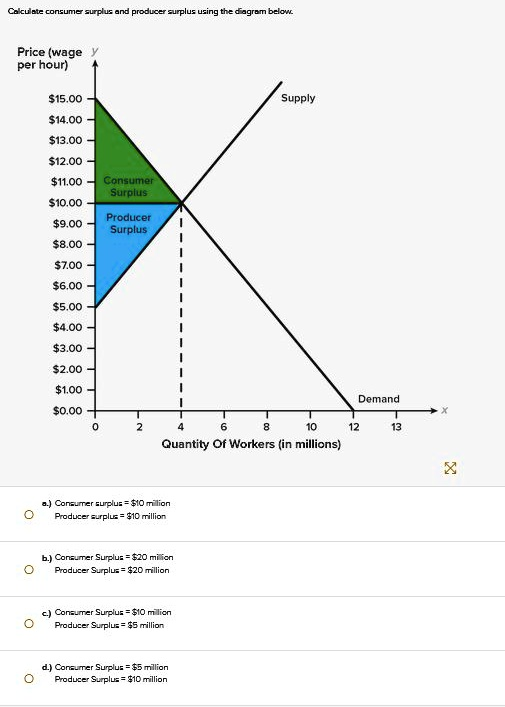Calculate consumer surplus and producer surplus using the diagram below.

The Correct Answer and Explanation is:
Correct Answer:
a.) Consumer surplus = $10 million, Producer surplus = $10 million
Explanation:
To determine the consumer surplus and producer surplus, we must first identify the equilibrium point and then calculate the area of the respective triangles on the graph.
1. Identifying the Equilibrium Point:
The equilibrium point occurs where the supply curve and the demand curve intersect. Looking at the diagram, this intersection happens at a price (wage per hour) of $10.00 and a quantity of 4 million workers.
- Equilibrium Price (Pe) = $10.00
- Equilibrium Quantity (Qe) = 4 million
2. Calculating Consumer Surplus (CS):
Consumer surplus represents the economic benefit to consumers, which in this labor market context are the employers demanding workers. It is the difference between the highest price they are willing to pay and the actual market price. Graphically, it is the area of the green triangle above the equilibrium price line and below the demand curve.
The area of a triangle is calculated using the formula: Area = 0.5 * base * height.
- Base of the CS triangle: The base is the equilibrium quantity of workers, which is 4 million.
- Height of the CS triangle: The height is the difference between the maximum wage employers are willing to pay (the y-intercept of the demand curve) and the equilibrium wage. The demand curve starts at $15.00. So, the height is $15.00 – $10.00 = $5.00.
Now, we can calculate the consumer surplus:
CS = 0.5 * (4 million) * ($5.00)
CS = 2 million * $5.00
CS = $10 million
3. Calculating Producer Surplus (PS):
Producer surplus is the economic benefit to producers, which are the workers supplying labor in this market. It is the difference between the market price they receive and the minimum price they are willing to accept. On the graph, this is represented by the area of the blue triangle below the equilibrium price line and above the supply curve.
We use the same formula for the area of a triangle.
- Base of the PS triangle: The base is also the equilibrium quantity of workers, which is 4 million.
- Height of the PS triangle: The height is the difference between the equilibrium wage and the minimum wage workers are willing to accept (the y-intercept of the supply curve). The supply curve starts at $5.00. So, the height is $10.00 – $5.00 = $5.00.
Now, we calculate the producer surplus:
PS = 0.5 * (4 million) * ($5.00)
PS = 2 million * $5.00
PS = $10 million
Therefore, the consumer surplus is $10 million and the producer surplus is $10 million, which corresponds to option (a).
